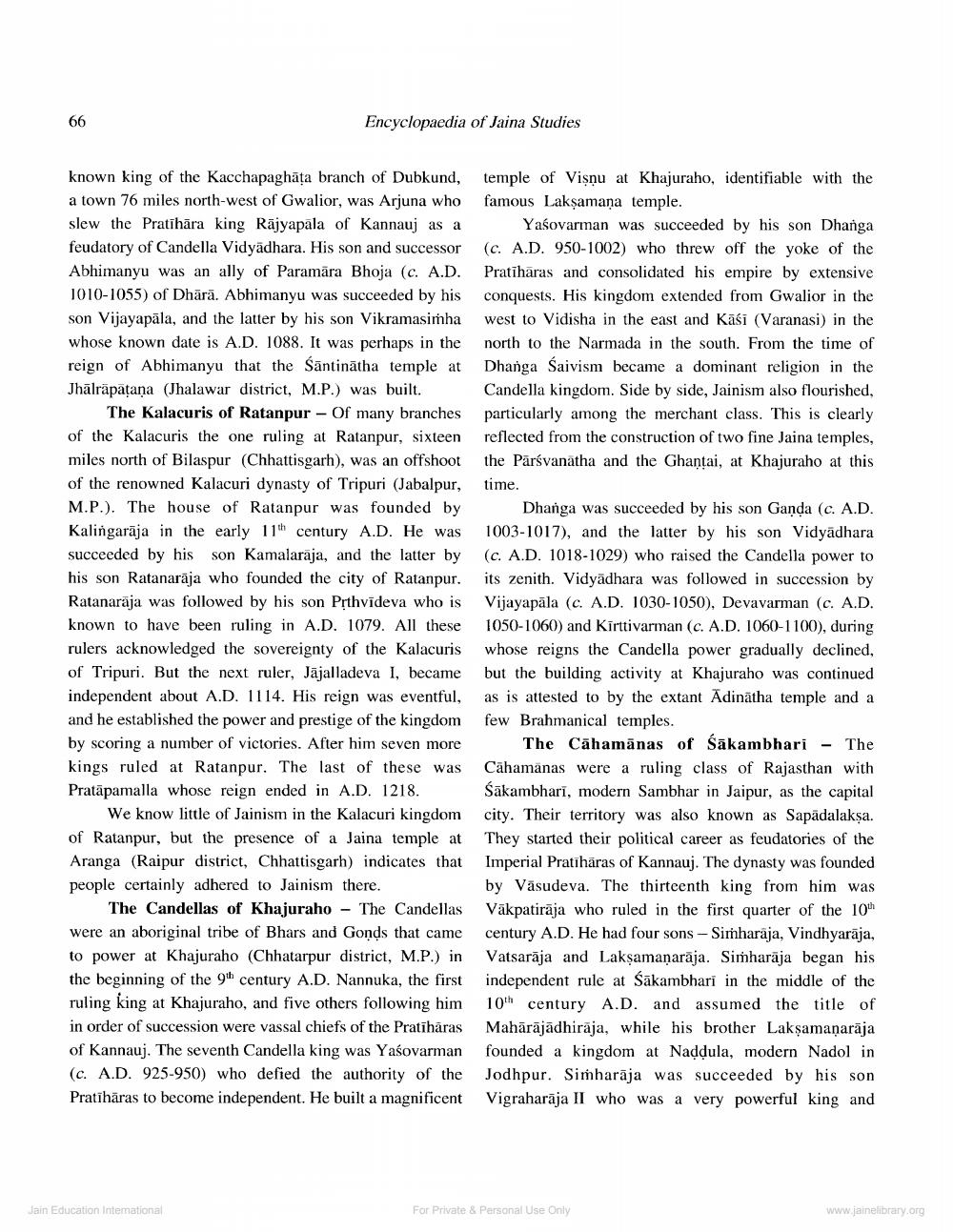________________
66
Encyclopaedia of Jaina Studies
known king of the Kacchapaghața branch of Dubkund, a town 76 miles north-west of Gwalior, was Arjuna who slew the Pratihāra king Rajyapala of Kannauj as a feudatory of Candella Vidyadhara. His son and successor Abhimanyu was an ally of Paramara Bhoja (c. A.D. 1010-1055) of Dhārā. Abhimanyu was succeeded by his son Vijayapala, and the latter by his son Vikramasimha whose known date is A.D. 1088. It was perhaps in the reign of Abhimanyu that the Santinātha temple at Jhalrāpāṭaṇa (Jhalawar district, M.P.) was built.
The Kalacuris of Ratanpur - Of many branches of the Kalacuris the one ruling at Ratanpur, sixteen miles north of Bilaspur (Chhattisgarh), was an offshoot of the renowned Kalacuri dynasty of Tripuri (Jabalpur, M.P.). The house of Ratanpur was founded by Kalingaraja in the early 11th century A.D. He was succeeded by his son Kamalaraja, and the latter by his son Ratanaraja who founded the city of Ratanpur. Ratanaraja was followed by his son Pṛthvideva who is known to have been ruling in A.D. 1079. All these rulers acknowledged the sovereignty of the Kalacuris of Tripuri. But the next ruler, Jajalladeva I, became independent about A.D. 1114. His reign was eventful, and he established the power and prestige of the kingdom by scoring a number of victories. After him seven more kings ruled at Ratanpur. The last of these was Pratapamalla whose reign ended in A.D. 1218.
We know little of Jainism in the Kalacuri kingdom of Ratanpur, but the presence of a Jaina temple at Aranga (Raipur district, Chhattisgarh) indicates that people certainly adhered to Jainism there.
The Candellas of Khajuraho - The Candellas were an aboriginal tribe of Bhars and Gonds that came to power at Khajuraho (Chhatarpur district, M.P.) in the beginning of the 9th century A.D. Nannuka, the first ruling king at Khajuraho, and five others following him in order of succession were vassal chiefs of the Pratihāras of Kannauj. The seventh Candella king was Yasovarman (c. A.D. 925-950) who defied the authority of the Pratihāras to become independent. He built a magnificent
Jain Education International
temple of Visņu at Khajuraho, identifiable with the famous Laksamana temple.
Yasovarman was succeeded by his son Dhanga (c. A.D. 950-1002) who threw off the yoke of the Pratihāras and consolidated his empire by extensive conquests. His kingdom extended from Gwalior in the west to Vidisha in the east and Kāśī (Varanasi) in the north to the Narmada in the south. From the time of Dhanga Śaivism became a dominant religion in the Candella kingdom. Side by side, Jainism also flourished, particularly among the merchant class. This is clearly reflected from the construction of two fine Jaina temples, the Parsvanatha and the Ghantai, at Khajuraho at this time.
Dhanga was succeeded by his son Ganda (c. A.D. 1003-1017), and the latter by his son Vidyadhara (c. A.D. 1018-1029) who raised the Candella power to its zenith. Vidyadhara was followed in succession by Vijayapala (c. A.D. 1030-1050), Devavarman (c. A.D. 1050-1060) and Kirttivarman (c. A.D. 1060-1100), during whose reigns the Candella power gradually declined, but the building activity at Khajuraho was continued as is attested to by the extant Adinatha temple and a few Brahmanical temples.
The Cahamānas of Sakambhari - The Cahamanas were a ruling class of Rajasthan with Śākambharī, modern Sambhar in Jaipur, as the capital city. Their territory was also known as Sapädalakṣa. They started their political career as feudatories of the Imperial Pratihāras of Kannauj. The dynasty was founded by Vasudeva. The thirteenth king from him was Vākpatiraja who ruled in the first quarter of the 10th century A.D. He had four sons - Simharaja, Vindhyaraja, Vatsaraja and Lakṣamaṇarāja. Simharaja began his independent rule at Śakambhari in the middle of the 10th century A.D. and assumed the title of Mahārājādhirāja, while his brother Lakṣamaṇarāja founded a kingdom at Nadḍula, modern Nadol in Jodhpur. Simharaja was succeeded by his son Vigraharaja II who was a very powerful king and
For Private & Personal Use Only
www.jainelibrary.org




